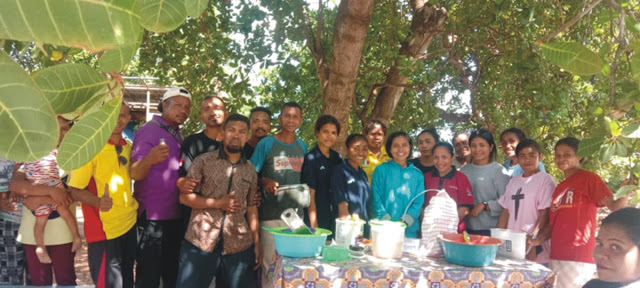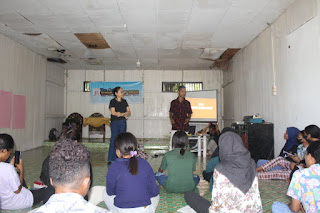The student participants of the camp at TSAP Sebanjar listened to an explanation of education issues by Makris Mau, a senior village assistant of Alor regency. Makris invited all students to think about education in the village. Common observation shows that many schools end at 10 am due to teacher shortage. How could it happen? It is not just a matter of limited teaching staff, but also lack of appropriate salary. Compared to Papua, the salary for contract teachers reaches up to two million rupiahs. Moreover, private parties take part in recruiting special teachers considering the importance of education to change a nation.
The resource person then invited students to observe the sources of people’s income and their allocation. For example, after they have incomes from candlenuts, vanilla, fish, livestock, and food crops, what they allocate the money for? Health, micro business, education, or parties? It will be interesting if it is examined because most people work for consumption. Related to economic actors, can we calculate how many entrepreneurs or small entrepreneurs are, and how many people run a kiosk in the village? In urban areas, the service sector is developing fast, from trade and culinary, like in Kalabahi mini square, however the workers are people coming from outside Alor. The condition affects economic development in Alor.
The market chain in Alor takes a long stage, so farmers get less benefit. Even though Alor is rich in fishery, no one invested in it, it is in contrast to East Flores. There is a large tuna factory that employs local manpower. Furthermore, Alor has tourism potency but is not well-optimized, for example, Kepa island dan Wolwal are managed by Frenchman, Jawa Toda’s Pantar island is handled by German, and Hirang is also developed by expatriates. Tourism will develop if the private sector takes the role and so does the government as regulator, so it is necessary to invite private investors to Alor. The potency of agriculture, culture, plantation, and forestry in Alor is competitive with other regions. For the reasons above Makris Mau encouraged the participants as well-educated students to return to their origin to contribute positively to village development by complementing mastery of digital technology.
There are several things to do in respond to the requirements above, such as 1) responsive capacity, sensitivity to be responsive to community aspirations; 2) the extractive capacity of the community and village government, namely the ability to mobilize and optimize village assets; 3) regulatory capacity, namely the ability to understand village development regulations; 4) distributive capacity, namely, the ability to share resources, who can work in the development sector, etc, according to the needs of the community; 5) collaborative capacity, that is, the ability of the village government and its citizens to build cooperative networks.
These capacities are the requirements for the participants to assist the improvement of the village government and its apparatus capacity. Now, young people understand the potencies of the village and how to develop it. ***













.png)




.jpg)




































How is health based on a Christian theological perspective? Many people do not understand well that health is a responsibility to maintain the temple of God because the human body is the temple of God. “Death occurs when the soul cannot survive in a weak body or dies. The soul exists only in a strong and healthy body.” That is the main point said by Eunike Molebila, S.Th., M.Th, a Theology Education lecturer at Tribuana University Kalabahi among students of Theology Study Progam at Tribuana Kalabahi University (12/2/2022).
Such bad health understanding is commonly seen in people’s daily activities such as unhealthy consumption patterns. Frequently, people often enslaved by food, and consume foods and drinks that affect health if they’re consumed excessively and even bring to addiction, such as chocolate, coffee, or tea. Those are scientifically harmful to human health.
During the dialogue, the participants shared their understanding and life experience to keep their bodies healthy. Amos Manisa shared his experience when he was in Junior High School, “I have become a smoker and consume liquor mixed with various drugs. Then, I repented when I was seriously ill and I decided to quit. Now, this is the second year I get out of my bad habit.”
During this pandemic, Eunike said, “The Covid-19 pandemic can be noted as a genocidal case made by humans by technology.” It requires a deep understanding of the power of wisdom and knowledge by the Christians to survive. The current relevant questions are about the covid-19 outbreak. Which one is the most important spiritual health or physical health? Can a Christian have both as the responses to the Covid-19? Of course, as a child of God, spiritual health is more important than physical health.
Covid-19 has changed the behavior of humans, people with nature, people with objects, people with politics, and even people with money and time. Is there any change in human attitude toward God too? The answer is yes, a positive change, people realized themselves as just ordinary who can die at any time and push them closer to God as personal creator and redeemer.
This discussion is expected to provide critical understanding to the participants’ understanding of what the Bible said about illness and how our faith should be in responding to the Covid-19 correctly and wisely. ***